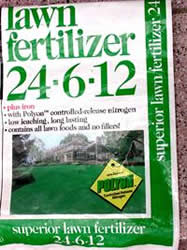There are a large number of fertilizers available today. Sometimes it is difficult to choose what type of fertilizer to use, what formulation should be used, and how it should be applied. The number of alternatives are confusing.
A primary consideration is the nutrient analysis of the fertilizer.
Every fertilizer bag, whether the fertilizer inside is synthetic or organic, will have a series of three numbers listed on it in the format X-Y-Z. The example shown in Figure 1 is 24-6-12.

Figure 1 - Bag of fertilizer
- The first number, X, indicates the percentage by weight of actual nitrogen in the fertilizer.
- The second number, Y, indicates the percentage by weight of phosphate.
- The third number, Z, indicates the percentage by weight of potash.
- Other nutrients contained in the fertilizer will be listed on the bag as well.
Conversion formulas for: phosphate to phosphorus and potash to potassium
These analyses allow the gardener to select a fertilizer which contains the nutrients necessary in their own situation.
The acidifying effect of a particular fertilizer is also a consideration. Nitrogen in the form of ammonium has an acidic reaction in the soil, while nitrogen as nitrates has an alkaline reaction. If your soil is acid and you are trying to raise the pH, avoid acidic fertilizers. On the other hand, if you are growing acid loving plants such as rhododendrons, avoid alkaline fertilizers.
Fast and slow release fertilizers are available, and both have pros and cons. Fast release fertilizers are immediately available to plants, but are also subject to rapid depletion from the soil via leaching or volatilization. It is also possible to damage plants by burning them when fast release fertilizers are applied too heavily. Slow release fertilizers are either organic materials which must be broken down by microbial activity before nutrients are available to plants, or are slowly soluble or coated fertilizers which depend on soil moisture to release them. There is little loss from leaching with these materials and the gardener will not have to apply them as frequently as for fast release fertilizers, but by the same token, there is not immediate nutrient availability to the plants. Either slow or fast release fertilizers can produce good results if used correctly. Slow release fertilizers are generally more expensive per pound, but the labor savings may be worth it.
Fertilizer formulation can affect the quality of results.
Granular and liquid formulations can be applied evenly and distributed to the entire root system.
Spikes, pellets, or fertilizer packets are convenient to use, but concentrate the fertilizer in one spot.
Method of application also affects results. For years, fertilizers have been injected with water or place in drilled holes near the root zone of trees, under the assumption that such placement put the fertilizer right where it was needed. Recent research has shown that the extra effort required by these methods is unnecessary, because broadcasting fertilizer is as effective or even more so. Drill hole placement of fertilizer can, however, be an effective way of aerating compacted soil.
